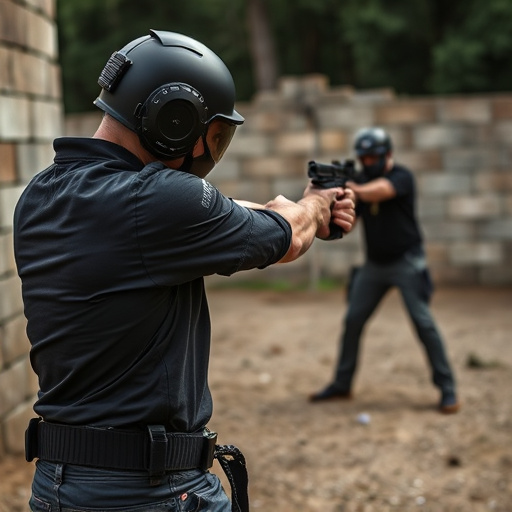Stun devices utilize high-voltage, low-amperage electric currents to disrupt nerve impulses and cause temporary loss of motor control through neuromuscular effects. This disruption enables users to escape or subdue an attacker for several seconds. Effective in self-defense, these devices interfere with body's electrical signaling without causing permanent damage. Their sound deterrent feature uses high-frequency sounds to disrupt aggressors' neuromuscular systems, offering a safe and powerful means of deterring attacks. Safety features ensure consistent and controlled shocks while protecting users and bystanders. Stun guns prove valuable in high-risk areas for crime prevention and self-defense, incapacitating assailants temporarily to escape or summon help.
“Stun guns, as non-lethal self-defense tools, utilize neuromuscular disruption to render targets incapacitation. This article delves into the science behind these devices’ effectiveness, focusing on the neuromuscular effects caused by their unique design. We explore how stun guns impair motor functions through electrical impulses, and examine the role of sound deterrents in enhancing their impact. By understanding the neurological impact of high-frequency sounds, we can assess the safety and reliability of modern stun gun features, and their real-world applications in crime prevention and self-defense.”
- Understanding Neuromuscular Disruption in Stun Devices
- How Stun Guns Impair Motor Functions
- The Science Behind Sound Deterrents' Effectiveness
- Neurological Impact of High-Frequency Sounds
- Evaluating Safety and Reliability of Stun Gun Features
- Real-World Applications: Crime Prevention and Self-Defense
Understanding Neuromuscular Disruption in Stun Devices

Stun guns operate by delivering an electric current that disrupts the neuromuscular system, leading to a temporary loss of motor control in the target. This effect is achieved through a combination of high voltage and low amperage, which directly impacts the nervous system. The electrical impulse interferes with nerve impulses, causing muscles to contract uncontrollably and resulting in paralyzing effects.
The neuromuscular disruption caused by stun devices can last for several seconds, providing users with enough time to escape or subdue an attacker. This temporary incapacitation is a game-changer in self-defense scenarios, as it allows individuals to regain control and seek safety promptly. The effectiveness of these devices relies on their ability to disrupt the body’s normal electrical signaling, making them powerful tools for personal security.
How Stun Guns Impair Motor Functions

Stun guns, also known as electroshock weapons, operate by delivering a powerful electric current through the body, targeting the neuromuscular system. This disruption has significant effects on motor functions, temporarily paralyzing muscles and rendering the target immobile. The electric current interferes with nerve impulses, causing involuntary muscle contractions and twitches, which can lead to a loss of balance and coordination.
These devices impair muscle control by disrupting the transmission of electrical signals between nerves and muscles. This neuromuscular disruption results in a powerful jolt that overloads the body’s natural systems, leading to temporary incapacitation. The effects are swift, ensuring the target is neutralized without causing permanent damage, making stun guns popular for self-defense applications.
The Science Behind Sound Deterrents' Effectiveness

The effectiveness of sound deterrents, particularly stun guns, lies in their ability to harness the neuromuscular system. When activated, these devices emit a powerful sound that can disrupt the neural signals responsible for muscle control in potential aggressors. This sudden interruption results in temporary incapacitation, providing the user with crucial time to escape or seek help.
The high-intensity noise from stun guns is designed to override the body’s natural responses, causing a range of physiological effects. It can lead to vertigo, disorientation, and muscle spasms, making it challenging for an individual to maintain balance and coordination. These neuromuscular effects are non-lethal but are enough to deter attacks, offering personal safety without resorting to more harmful measures.
Neurological Impact of High-Frequency Sounds

One of the least discussed yet potent aspects of stun guns is their sound deterrent feature, which leverages high-frequency sounds to disrupt potential attackers. These devices emit sonic waves that can have significant neurological impacts, specifically targeting the neuromuscular system. The high-pitched, often inaudible to human ears, tones interfere with nerve impulses and muscle contractions, temporarily paralyzing or disorienting the target. This disruption is achieved without causing lasting harm, making stun guns effective non-lethal self-defense tools.
The neuromuscular effects of stun devices are swift and intense. The high-frequency sounds can disrupt the electrical signals that muscles rely on for movement, leading to a sudden loss of control or immobilization. This phenomenon is particularly useful in self-defense scenarios, providing individuals with a critical window of opportunity to escape or seek help. By exploiting these neurological mechanisms, stun guns offer a safe and powerful means of deterring and disabling assailants without resorting to lethal force.
Evaluating Safety and Reliability of Stun Gun Features

When evaluating stun gun features, safety and reliability are paramount. It’s crucial to understand the neuromuscular effects of stun devices to ensure their efficacy as deterrents. The primary goal is to temporarily incapacitate an aggressor without causing serious harm, focusing on disrupting muscle control and nerve impulses.
Reliable stun guns should deliver a consistent electrical shock that overrides the body’s natural reflexes. This is achieved through factors like high voltage output, precise current delivery, and robust design. Safety features such as automatic shut-off mechanisms after activation and human safety controls ensure that bystanders and users themselves are protected from accidental shocks or overuse.
Real-World Applications: Crime Prevention and Self-Defense
Stun guns, with their potent neuromuscular effects, offer more than just a deterrent; they are powerful tools for crime prevention and self-defense in real-world scenarios. The immediate incapacitation provided by these devices gives individuals an invaluable window of opportunity to escape dangerous situations or summon help. This is particularly crucial in high-risk environments like urban areas with high crime rates, where folks may find themselves vulnerable to physical assaults.
The effectiveness of stun guns lies in their ability to disrupt an assailant’s neuromuscular function, rendering them temporarily immobilized. This feature makes it easier for potential victims to defend themselves and increase their chances of survival until law enforcement arrives. Moreover, the non-lethal nature of these devices ensures that bystanders remain unharmed, fostering a safer public space without resorting to more extreme measures.
The neuromuscular effects of stun devices, as explored in this article, highlight their unique ability to disrupt an assailant’s motor functions. Sound deterrents, with their high-frequency capabilities, offer an additional layer of protection by targeting the nervous system. The scientific evidence supports their effectiveness as a non-lethal self-defense tool. When combined with proper training and safety considerations, stun guns equipped with sound deterrent features prove invaluable in real-world scenarios, empowering individuals to protect themselves while navigating potential threats. Understanding these technological advancements is key to embracing innovative solutions for personal safety.
